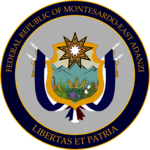1st Montesardi Republic
| Montesardi National Republic República Nacional y Central de Montesardo-Adanzi del Este
| |||||
|---|---|---|---|---|---|
|
|||||
|
|||||
| Motto: Libertas Et Patria | |||||
| Anthem: Mirad, la Prosperidad. | |||||
| Region | Western Borealia | ||||
| Capital | New Puledra City | ||||
| Government | Authoritarian republic | ||||
| Currency | Silver Bit | ||||
| Today part of | Template:Country data North Fillicia 25px Virranacce |
||||
The First Montesardi Republic, (officially known by the constitution as The National and Central Republic of Montesardo-East Adanzi), was a former nation in Foronna that consisted of the remains of Montesardo, parts of Virranacce and of Fillicia. Its political formation and power was significant, leading in the fall of the Fillician Empire and the spread of liberal ideas, alongside the expansion of Montesardi influence around Borealia.
The state originated from the fractured and war-torn remains of the nations around the Montesardi plains and the Cilland Mountain Range, notably Nevarro and the former Central Republic. The nation was known for having little stability and political control after 1915, with the resignation of Anna Ezmeraldi Fulgencie Allamar, which lead to the crumbling of the government structure as a whole.
Overview
Civil harmony was managed after the end of the War of Union leading to the foundation of the republic. With former generals, civil administrators and powerful landowners, the Convention of Unión y Prospecto held on the 15th of September of 1894, the nation was officially formed in a sort of autocratic regime. It was allowed a grace period of five years to reorganise the fractured states, until the Federal Constitution was signed and established.
While this was eventful, border crisis with Virranacce and Fillicia kept tensions high, with Montesardo-East Adanzi failing to secure legitimacy over its areas, much less claims to it. Foreign policy began a spark, even with low prestige. The nation instead started mass campaigns in foreign policy, offering to host embassies of those nations to establish ties and relations with them. This overall was successful, with the nations taking some interest into the newly formed nation. The foreign policy initiative was effective at re-establishing some of the prestige of the Montesardi, but what allowed the nation to recover most of it was the rapid reconstruction of the navy and its engagements against pirates around Charnea and in Northern Foronna.
End of the Monarchy in Montesardo
Political turmoil sky-rocketed as soon as Lubyakan troops occupied New Puledra. With the surrender of the Royal Army, and the annihilation of the Central Army, civilians began to riot against the foreign occupier. The riots (referred to as the New Puledran massacres) resulted in the deaths of over 100 Montesardi and 30 Lubyakan-Fillician soldiers. The chaos provoked from three weeks of riots only encouraged King Alfredo zu Yamatsburg to flee the country in self imposed exile to Amalfi, leaving the nation effectively without a head of state. Lubyakans and Fillicians continued to occupy Montesardo for over a year as a result, until an official government was formed in New Puledra City with the provisional Constitution of Montesardo and Adanzi in 15th of September of 1894, effectively ending the Monarchy. This government was formed after capturing the Triessamme Palace (now known as Parliamentary Palace) from Lubyakan occupiers, slaughtering them with overwhelming numbers. By then, the Lubyakan and Fillician occupying force was too demoralised to continue suppressing the almost daily riots and skirmishes and retreated back to their homelands as soon as the government was formed.
| |||||||||||||||||||||||||||||||||||||||||||||||




